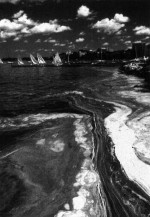Understanding how processes at multiple spatial and temporal scales interact to affect lake ecosystems
he North Temperate Lakes (NTL) LTER project has as its main goal the understanding of how processes occurring at multiple spatial and temporal scales interact to affect lake ecosystems. Within this central goal, we have identified five areas of special attention:
- Detecting long-term trends in lake ecosystem properties
- Understanding interactions of physical, chemical, and biological processes in lakes and their surrounding landscapes
- Determining the role of disturbance and stress in structuring lake ecosystems
- Understanding the relationship between spatial heterogeneity and temporal dynamics
- Identifying regional patterns and processes affecting inland lakes at the scale of the Upper Great Lakes area of North America
Recent Site Augmentation
Historically, the North Temperate Lakes site has been focused on seven primary study lakes in the Northern Highland Lake District in Wisconsin. A recent augmentation has allowed us to extend our current work from lakes in northern Wisconsin to lakes in southern Wisconsin and Ontario. These increases in extent of the North Temperate Lake LTER add two important components to our first 14 years of LTER research.
First, lakes have been added from agricultural watersheds (Fish and Mendota) and urban watersheds (Wingra and Monona). The goal was to include ecosystems, incorporating strong interactions with humans. The LTER project should provide important clues on how land use affects land-water interactions and lake ecosystems. One focus will be to understand the interaction between the chemistry, physics and biology of lakes in relation to human behaviors. For example, in agricultural regions, the sociological processes that lead individual farmers to decide how much fertilizer to use may be a critical determinant of phosphorus loading to lakes.
Second, we have established close interactions with two of the foremost limnological research centers in North America, the Experimental Lakes Area in western Ontario, and the Dorset Research Centre, just east of Georgian Bay in central Ontario (see next page). These interactions are allowing us, along with our Canadian colleagues, to regionalize our understanding of processes affecting small inland lakes to the Upper Great Lakes region of North America.
The two overarching questions in our augmentation are:
- Do the dominant factors controlling inland lake ecosystems, and the predictability of their effects vary systematically as spatial scales expand from individual lakes to watersheds, to lake districts, to broader regions, and temporal scales extend from years to decades to centuries?
- How have natural and human-induced changes in the landscape interacted with aquatic ecosystem structure and dynamics in the Upper Great Lakes Region over the past two centuries, and what changes can be expected over the next hundred years?
We welcome researchers to join in collaborative research. For more information, examine the North Temperate Lakes LTER home page on the World Wide Web (http://lter.limnology.wisc.edu/) or contact John Magnuson (jMagnuson@lternet.edu) or Tim Kratz (tKratz@lternet.edu).

 Enlarge this image
Enlarge this image